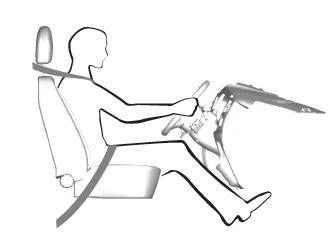Ford Escape 2020-2025 Service Manual / Chassis / Brake System / Brake System - General Information / General Procedures - Component Bleeding - Vehicles With: Vacuum Brake Booster
Ford Escape: Brake System - General Information / General Procedures - Component Bleeding - Vehicles With: Vacuum Brake Booster
Special Tool(s) / General Equipment
| Master Cylinder Bleeding Set |
Bleeding
NOTICE: If the fluid is spilled on the paintwork, the affected area must be immediately washed down with cold water.
Master Cylinder
NOTE: When a new brake master cylinder has been installed, it should be primed to prevent air from entering the system.
-
NOTE: Make sure the area around the master cylinder cap is clean and free of foreign material.
Remove the brake fluid reservoir cap.
 |
-
Fill the reservoir with clean, specified brake fluid.
Refer to: Specifications (206-00 Brake System - General Information, Specifications).
 |
-
Loosen and remove the brake tube fittings.
 |
-
Install the master cylinder bleeding set.
Use the General Equipment: Master Cylinder Bleeding Set
 |
-
Have an assistant pump the brake pedal slowly until clear bubble free fluid flows from the brake tubes.
 |
-
Remove the master cylinder bleeding set.
Remove the General Equipment: Master Cylinder Bleeding Set
 |
-
Tighten the brake tube fittings.
Refer to: Specifications (206-00 Brake System - General Information, Specifications).
 |
-
Fill the reservoir with clean, specified brake fluid.
Refer to: Specifications (206-00 Brake System - General Information, Specifications).
 |
-
Refer to: Brake System Pressure Bleeding - Vehicles With: Vacuum Brake
Booster (206-00 Brake System - General Information, General Procedures).
Brake Caliper, Wheel Cylinder, Brake Hose or Brake Tube
-
NOTE: Pressure bleeding the brake system is required anytime a hydraulic brake system component has been disconnected.
Refer to: Brake System Pressure Bleeding - Vehicles With: Vacuum Brake Booster (206-00 Brake System - General Information, General Procedures).
 General Procedures - Brake System Pressure Bleeding - Vehicles With: Vacuum Brake Booster
General Procedures - Brake System Pressure Bleeding - Vehicles With: Vacuum Brake Booster
Special Tool(s) /
General Equipment
Brake/Clutch System Pressure Bleeder/Filler
Fluid Container
Bleeding
All vehicles
NOTICE:
If the fluid is spilled on the paintwork, the affected area must be immediately washed down with cold water...
Other information:
Ford Escape 2020-2025 Owners Manual: Using the Remote Control
Use your remote control to access various vehicle systems. Note:The buttons on your remote may vary depending on the vehicle region or options. Unlock Press the button to unlock all doors. Lock Press the button to lock all doors. Remote Start (If Equipped) Press the button to remote start. Liftgate (If Equipped) Press the button to open or close the liftgate. Panic Alarm Press the butto..
Ford Escape 2020-2025 Service Manual: General Procedures - Cylinder Block Distortion
Special Tool(s) / General Equipment Feeler Gauge Check NOTE: Refer to the appropriate Section 303-01 for the specification. NOTE: Use a Straightedge that is calibrated by the manufacturer to be flat within 0.005 mm (0.0002 in) per running foot of length, such as Snap-On® GA438A or equivalent. For example, if the Straightedge is 61 cm (24 in) long, the machined edge m..
Categories
- Manuals Home
- 4th Generation Ford Escape Owners Manual
- 4th Generation Ford Escape Service Manual
- Accessing the Trip Computer. Resetting the Trip Computer
- Locating the Pre-Collision Assist Sensors
- Fuel Quality
- New on site
- Most important about car
Sitting in the Correct Position

When you use them properly, the seat, head restraint, seatbelt and airbags will provide optimum protection in the event of a crash.
Copyright © 2025 www.fordescape4.com

